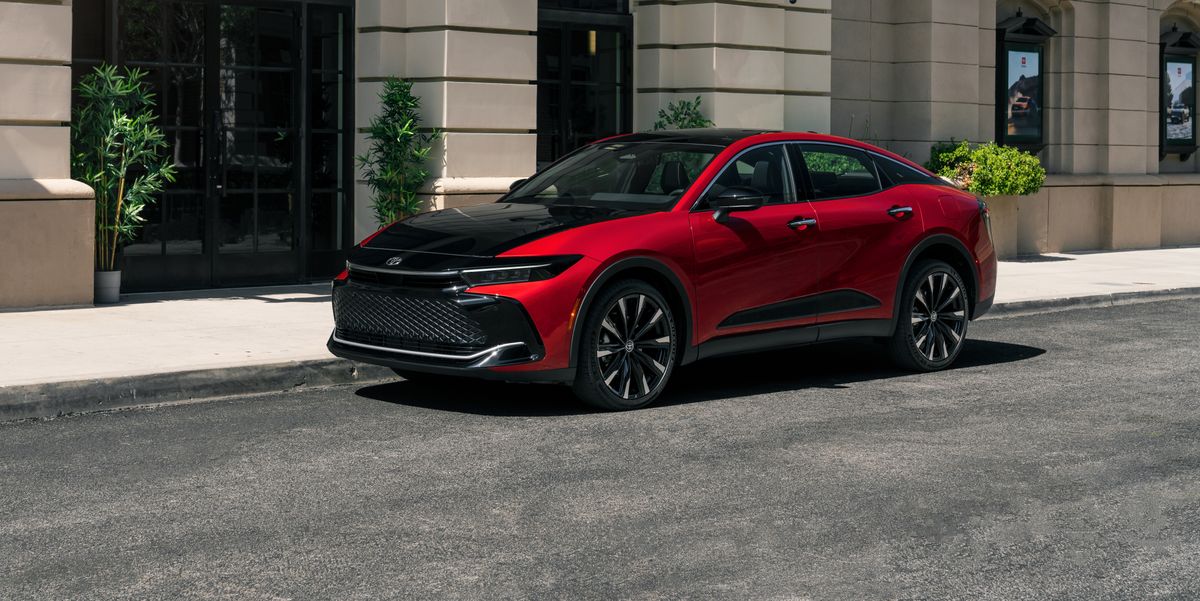- The Toyota Crown returns to the US lineup after its departure in the early 1970s.
- The new Crown uses two different hybrid systems and introduces the Toyota Hybrid Max powertrain.
- Pricing is still TBD, but you can expect the Crown to start north of $40,000.
Toyota’s Crown didn’t find lasting success on its first trip to the United States, but after a 50-year break, it’s back. After dropping the Avalon sedan, the folks at Toyota are slotting the Crown in the full-size hole in its lineup. While the Avalon was a true, large sedan, its Crown replacement blurs the lines between a crossover coupe and a sedan. The Crown will also arrive in the US exclusively with hybrid powertrains.
The ’23 Toyota Crown comes standard with a 2.5-liter naturally aspirated four-cylinder gasoline engine that works with a pair of electric motors. This is effectively the same hybrid system you’ll find on a handful of other Toyota products and should be good for 236 hp and a fuel-sipping 38 mpg combined. The other powertrain introduces Toyota’s Hybrid Max into the company’s lineup, with a 2.4-liter turbocharged I4 working with an electric rear axle to make 340 hp. This is less efficient than the standard hybrid system and only hits a Toyota-estimated 28 mpg. The Hybrid Max also uses a six-speed automatic instead of the traditional Toyota eCVT you’ll find on the other powertrain. The downside: this powertrain is limited to the top-tier Platinum trim level, with the 2.5-liter hybrid powertrain slotting under the hood of the rest of the Crown models.
The Crown is a bigger story than just what’s under the hood. Toyota says it features a “lift-up” style, which might help sway folks into a sedan. The new Crown rides four inches higher than the Camry and should give drivers the higher seating position they crave from crossovers and SUVs.
Suspending the Crown is a pair of MacPherson struts in the front and a multi-link suspension in the rear. This setup should help control the standard 19-inch wheels on the XLE and the upgraded 21-inch wheels on the rest of the Crown lineup. Toyota also opted for an electronically controlled brake system that features Active Cornering Assist, intended to help reduce understeer.
On the inside, the Crown lives up to its regal name. Sitting atop the dashboard is a 12.3-inch touchscreen media system, in every Crown. This standard screen flanks a 12.3-inch digital instrument cluster that also makes its way into every Crown. These large screens push the Toyota Crown firmly into the evolving screen wars we’re seeing throughout the automotive world. Woven fabric covers the seats in base-model cars, but Limited cars see Softex seat coverings. Top-tier Platinum models get leather seats.
Beyond large screens, the Toyota Crown will offer digital keys, which connect through the Toyota app, on Platinum and cars equipped with the advanced tech package. This means you can leave your physical fob at home and still have full control over your Crown. Toyota also tacked on its advanced parking system on Platinum models. This system takes care of parking your Crown for you and controls steering, braking, and throttle input. Safety tech joins the Crown across the trim levels with the Toyota Safety Sense 3.0. This system brings pre-collision warnings when pedestrians, motorcyclists, and guardrails are detected. The Crown also comes with adaptive cruise control, lane departure alert with steering assist, and automatic high beams.
Toyota hasn’t mentioned pricing yet, but this full-size sedan probably won’t be priced like a Corolla. Considering the now-absent Avalon started just shy of $40,000, you can probably expect the Crown to crest $40,000, probably around $45,000. We’ll know for sure when the Crown heads to market before the end of the year.
Is this high-riding sedan the solution for dragging crossover customers back to cars? Or is the Crown a sign that sedans are crossing over? Let us know your thoughts below.
This content is created and maintained by a third party, and imported onto this page to help users provide their email addresses. You may be able to find more information about this and similar content at piano.io
